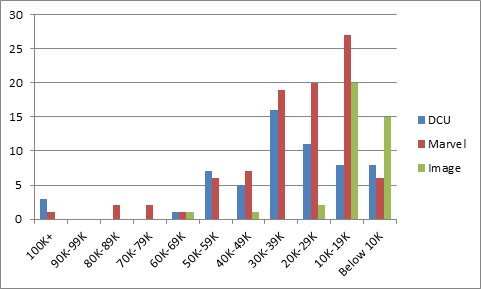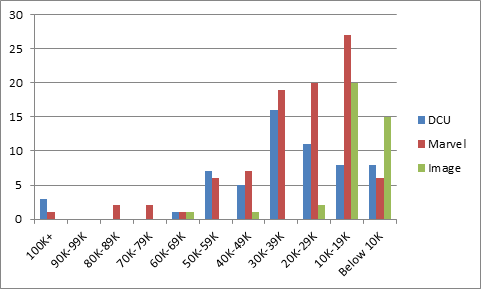And finally, the comparison chart of DC, Marvel and Image. So we can see where the biggest sales sit on the Direct Market Landscape.
Standard disclaimers: The numbers are based on the Diamond sales charts as estimated by the very reliable John Jackson Miller. These charts are pretty accurate for U.S. Direct Market sales with the following caveats: 1) you can add ~10% for UK sales, which are not reflected in these charts; 2) everyone’s best guess is you can add ~10% for digital sale – while some titles do sell significantly better in digital (*cough* Ms. Marvel *cough*), that’s the average rule of thumb; 3) it’s not going to include reorders from subsequent months, although reorders will show up in subsequent months if they’re high enough. So if you’re a monster seller in Southampton and the it took the US audience 3 weeks to reorder, it’s probably not going to be reflected here.
What’s a sales band? It’s another way to have a higher level view of the market. The general idea is to divide the market into bands of 10K copies sold and see how many issues are in each band. How many issues sold between 90-99K copies, 80-89K copies, etc. etc. In very broad terms, the market is healthier when there are several titles selling in the 70K-100K+ range because titles that move a lot of copies give the retailers some margin of error on their ordering. When you see titles selling in the 20-29K band and especially below, there’s a pretty good chance a lot of retailers aren’t ordering those titles for the shelf (pull box/pre-order only) or minimal shelf copies at best.
First up, the full chart with all the Events and Marvel’s cornucopia of #1s + Variant Covers.
No matter how you view the ordering, it’s pretty sparse until you get down to that 50K-59K sales band. Ongoing titles really seem to hit a brick wall before they can reach 60K in the Diamond estimates.
Let me reiterate something: depending on who you talk to, there are somewhere between 2500-3000 DM stores. The question is really how many stores are “full service” and how many are just stocking a few titles to supplement the store’s mainly non-comics merchandise. Depending on the number you pick, a title needs to sell 25K-30K copies to average 10 copies per store. This isn’t as much of a thing for Image because most stores don’t seem to stock Image for the shelves with the likely exception of a few things like Walking Dead and Saga. But even with those caveats, look at that chart and get a sense of what percentage of titles from the major players are going to be stocked at under 10 copies/per store with low to no copies for people who buy off the shelf (as opposed to pre-orders/in-store subscriptions).
The 30K-39K band does looks slightly healthier as the overall top list slides a bit, but that trade off probably isn’t the first one anyone would care to make.
When you take out those events and Marvel’s #1 + Variant Covers set, there goes the top list. Batman, Star Wars, Walking Dead and All-Star Batman (for a bit longer) and then the rest of the titles start to fall in line. With All-Star Batman wrapping up soon, if Kirkman were to wrap up Walking Dead, that would leave only 2 ongoing titles selling in the 60K+ range. That’s nuts. The prospect of only having 3 ongoings selling 60K+ post-All-Star Batman is equally strange.
The retailer pushback against Marvel’s minimum orders for lenticular covers makes you wonder what the future is going to hold for the Variants + 1 sales programs that’s been Marvel’s Direct Market bread and butter. There isn’t necessarily anything wrong with collecting variants, but the way Marvel’s been translating collector demand into retailers over-ordering somewhat camouflages the real audience size and the retailers are starting to draw a line they don’t wish to cross. I’ve been half expecting Marvel to experiment with higher priced variants as an alternative to minimum orders. It might not fly, but it would be a little more upfront than the calculus retailers have to do when they price variants based on how many extra copies they’re going to have to eat to be able to order said variant.
Do Events still work? Metal’s preludes sure seem to. Secret Empire does, at least in the main mini-series, but it’s not putting up the numbers Marvel is used to. Even in decline, it’s still a big sales step up from the ongoing Marvel titles. I think everyone would feel better if more ongoings sold well, but that’s what the sales trends are. Is over production to blame? Could be. But you’d think there’d be a couple more titles like Batman sticking their heads above the crowd.
Once again, if you throw out Batman and Star Wars as statistical anomalies, DC and Marvel’s main difference is that Marvel is putting out a lot more material estimated at selling under 30K. The mid-list, which is what passes for a top list this days, of 30K-59K is a similar title count.
Also see:
DC sales distribution for July
Marvel sales distribution for July
Want to learn more about how comics publishing and digital comics work? Try Todd’s book, Economics of Digital Comics or have a look at his horror detective series on Patreon.






I’m all for Marvel just pricing variants at higher prices and kind of wish the idea of rare variants went away entirely.
General question – do we have any idea if more people are actually reading comics than 10 or 20 years ago? Seems to me it’s becoming more of a fringe market at the same time as the general audience awareness of comic book characters has grown. I’m kind of blaming high prices, decompressed story-telling, over-reliance on insular continuity, really long mega-arcs, too many events, and too many cancellations and relaunches for fewer readers if there are fewer readers today.
It’s just that there are so many other forms of entertainment that provide more bang for the buck that it seems hard or comics to attract enough new readers to help replace older readers who are aging out or getting tired or Marvel or DC.
Hope I’m wrong but sometimes I feel as if there might only be around 50,000-75,000 people or so who are still active comic readers.
Batman’s been selling over 100K regularly without super variant overdrive, so it has to be over 100K. Walking Dead moves massive numbers in book form. But an audience figure for single issue comics? I haven’t seen one.
I’d prefer ALL variants go away but that’s not realistic, especially with current circulation figures. The only way publishers will reduce variants is if they fail to earn their keep.
LL
Comic readers probably number in the millions if you include digital (both catalog and subscription) and trades. Saga Vol. 1 TPB has sold *at least* 300,000 copies,
Even floppy readers likely number higher than 100,000. Retailers order more than 6 million floppies a month. Despite variants, I somehow doubt majority of customers buy 100+ floppies a month.
the number is huge.
I think the second chart is wrong, in that it’s just the first one repeated.
Comments are closed.